Evaluating UK Policies on Tobacco Addiction and Smoking
VerifiedAdded on 2021/08/23
|31
|8095
|368
Report
AI Summary
This report examines tobacco addiction and smoking in the UK, focusing on policy initiatives aimed at cessation. It begins with an abstract that highlights the study's aim to evaluate these policies, using the UK as a case study and secondary data for analysis. The introduction provides a global overview of tobacco usage, its health impacts, and the various control measures implemented by governments, including the UK. The report delves into the background of tobacco's effects on health, citing research on mortality, morbidity, and the link between smoking and diseases. The rationale emphasizes the importance of understanding smoking cessation policies and their effectiveness, with a focus on protecting non-smokers and assisting smokers in quitting. The research aims to assess the UK's policy initiatives, evaluate tobacco addiction prevalence, and provide recommendations. The methodology chapter outlines the interpretivism research philosophy and an inductive approach, justifying the use of a qualitative study design. The study design utilizes a qualitative approach, reviewing literature on tobacco addiction, smoking, and policy initiatives to address the research questions and objectives. The report aims to provide a comprehensive analysis of the current situation and past policies related to tobacco addiction and smoking in the UK.

Paraphrase This Document
Need a fresh take? Get an instant paraphrase of this document with our AI Paraphraser
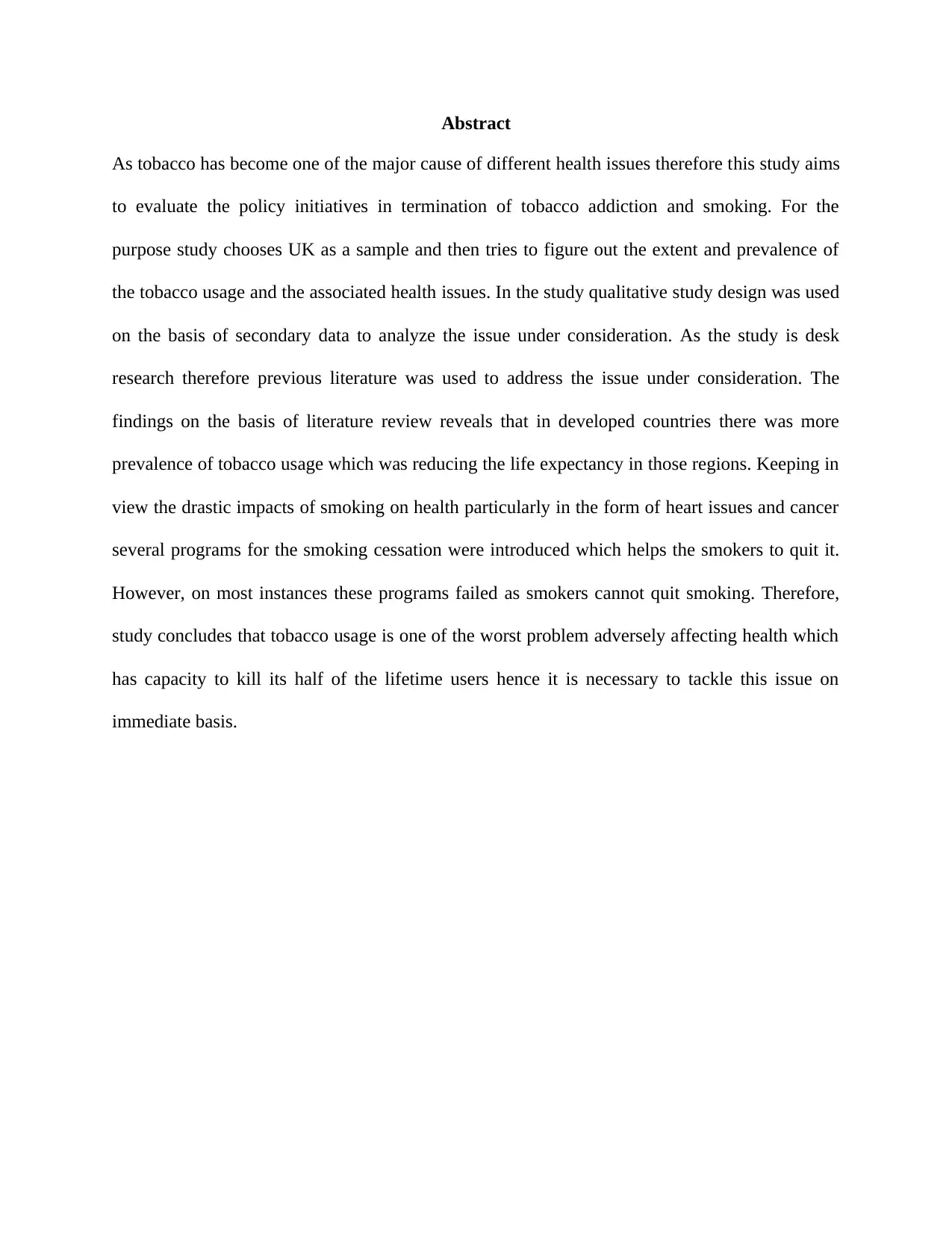
Abstract
As tobacco has become one of the major cause of different health issues therefore this study aims
to evaluate the policy initiatives in termination of tobacco addiction and smoking. For the
purpose study chooses UK as a sample and then tries to figure out the extent and prevalence of
the tobacco usage and the associated health issues. In the study qualitative study design was used
on the basis of secondary data to analyze the issue under consideration. As the study is desk
research therefore previous literature was used to address the issue under consideration. The
findings on the basis of literature review reveals that in developed countries there was more
prevalence of tobacco usage which was reducing the life expectancy in those regions. Keeping in
view the drastic impacts of smoking on health particularly in the form of heart issues and cancer
several programs for the smoking cessation were introduced which helps the smokers to quit it.
However, on most instances these programs failed as smokers cannot quit smoking. Therefore,
study concludes that tobacco usage is one of the worst problem adversely affecting health which
has capacity to kill its half of the lifetime users hence it is necessary to tackle this issue on
immediate basis.
As tobacco has become one of the major cause of different health issues therefore this study aims
to evaluate the policy initiatives in termination of tobacco addiction and smoking. For the
purpose study chooses UK as a sample and then tries to figure out the extent and prevalence of
the tobacco usage and the associated health issues. In the study qualitative study design was used
on the basis of secondary data to analyze the issue under consideration. As the study is desk
research therefore previous literature was used to address the issue under consideration. The
findings on the basis of literature review reveals that in developed countries there was more
prevalence of tobacco usage which was reducing the life expectancy in those regions. Keeping in
view the drastic impacts of smoking on health particularly in the form of heart issues and cancer
several programs for the smoking cessation were introduced which helps the smokers to quit it.
However, on most instances these programs failed as smokers cannot quit smoking. Therefore,
study concludes that tobacco usage is one of the worst problem adversely affecting health which
has capacity to kill its half of the lifetime users hence it is necessary to tackle this issue on
immediate basis.
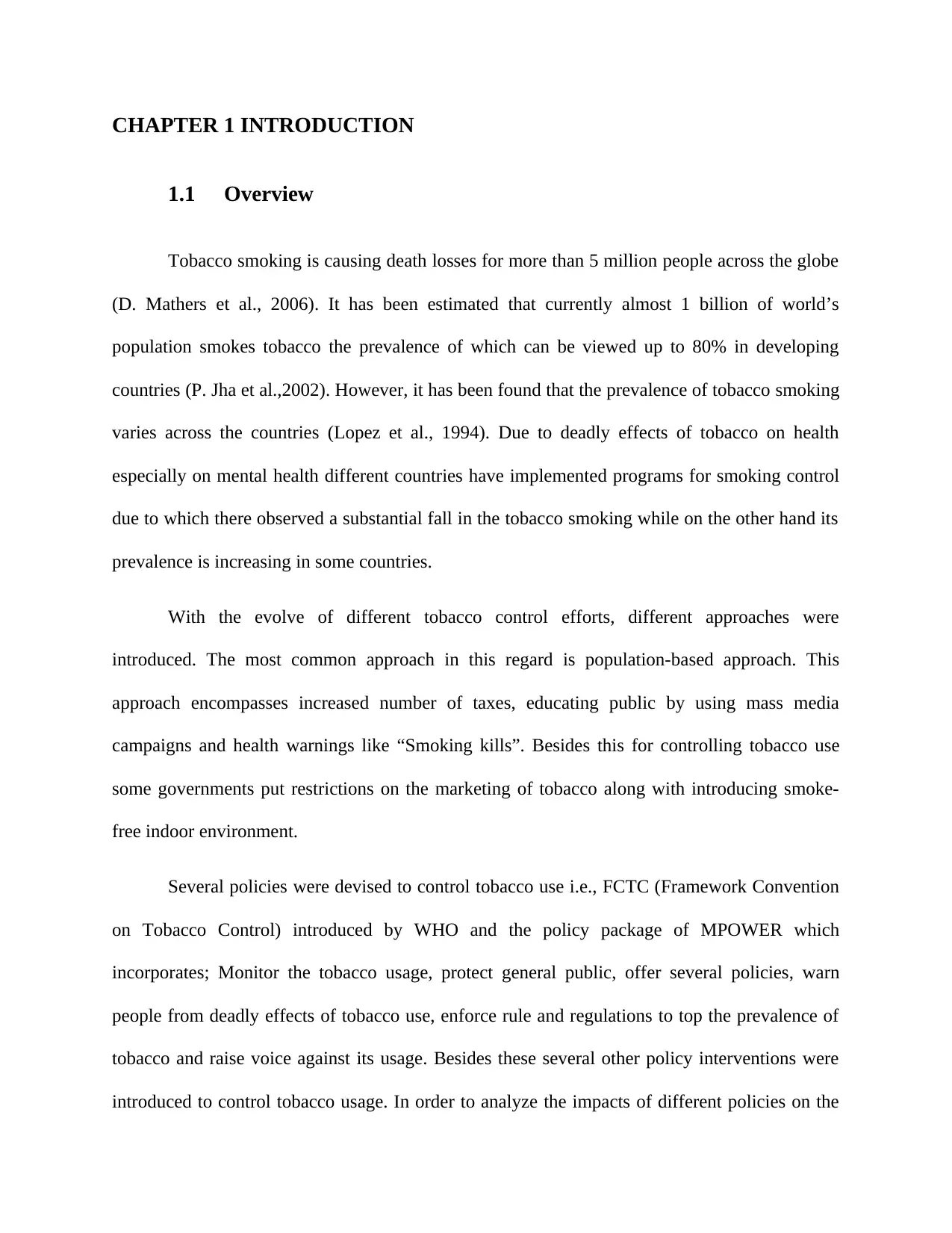
CHAPTER 1 INTRODUCTION
1.1 Overview
Tobacco smoking is causing death losses for more than 5 million people across the globe
(D. Mathers et al., 2006). It has been estimated that currently almost 1 billion of world’s
population smokes tobacco the prevalence of which can be viewed up to 80% in developing
countries (P. Jha et al.,2002). However, it has been found that the prevalence of tobacco smoking
varies across the countries (Lopez et al., 1994). Due to deadly effects of tobacco on health
especially on mental health different countries have implemented programs for smoking control
due to which there observed a substantial fall in the tobacco smoking while on the other hand its
prevalence is increasing in some countries.
With the evolve of different tobacco control efforts, different approaches were
introduced. The most common approach in this regard is population-based approach. This
approach encompasses increased number of taxes, educating public by using mass media
campaigns and health warnings like “Smoking kills”. Besides this for controlling tobacco use
some governments put restrictions on the marketing of tobacco along with introducing smoke-
free indoor environment.
Several policies were devised to control tobacco use i.e., FCTC (Framework Convention
on Tobacco Control) introduced by WHO and the policy package of MPOWER which
incorporates; Monitor the tobacco usage, protect general public, offer several policies, warn
people from deadly effects of tobacco use, enforce rule and regulations to top the prevalence of
tobacco and raise voice against its usage. Besides these several other policy interventions were
introduced to control tobacco usage. In order to analyze the impacts of different policies on the
1.1 Overview
Tobacco smoking is causing death losses for more than 5 million people across the globe
(D. Mathers et al., 2006). It has been estimated that currently almost 1 billion of world’s
population smokes tobacco the prevalence of which can be viewed up to 80% in developing
countries (P. Jha et al.,2002). However, it has been found that the prevalence of tobacco smoking
varies across the countries (Lopez et al., 1994). Due to deadly effects of tobacco on health
especially on mental health different countries have implemented programs for smoking control
due to which there observed a substantial fall in the tobacco smoking while on the other hand its
prevalence is increasing in some countries.
With the evolve of different tobacco control efforts, different approaches were
introduced. The most common approach in this regard is population-based approach. This
approach encompasses increased number of taxes, educating public by using mass media
campaigns and health warnings like “Smoking kills”. Besides this for controlling tobacco use
some governments put restrictions on the marketing of tobacco along with introducing smoke-
free indoor environment.
Several policies were devised to control tobacco use i.e., FCTC (Framework Convention
on Tobacco Control) introduced by WHO and the policy package of MPOWER which
incorporates; Monitor the tobacco usage, protect general public, offer several policies, warn
people from deadly effects of tobacco use, enforce rule and regulations to top the prevalence of
tobacco and raise voice against its usage. Besides these several other policy interventions were
introduced to control tobacco usage. In order to analyze the impacts of different policies on the
⊘ This is a preview!⊘
Do you want full access?
Subscribe today to unlock all pages.

Trusted by 1+ million students worldwide
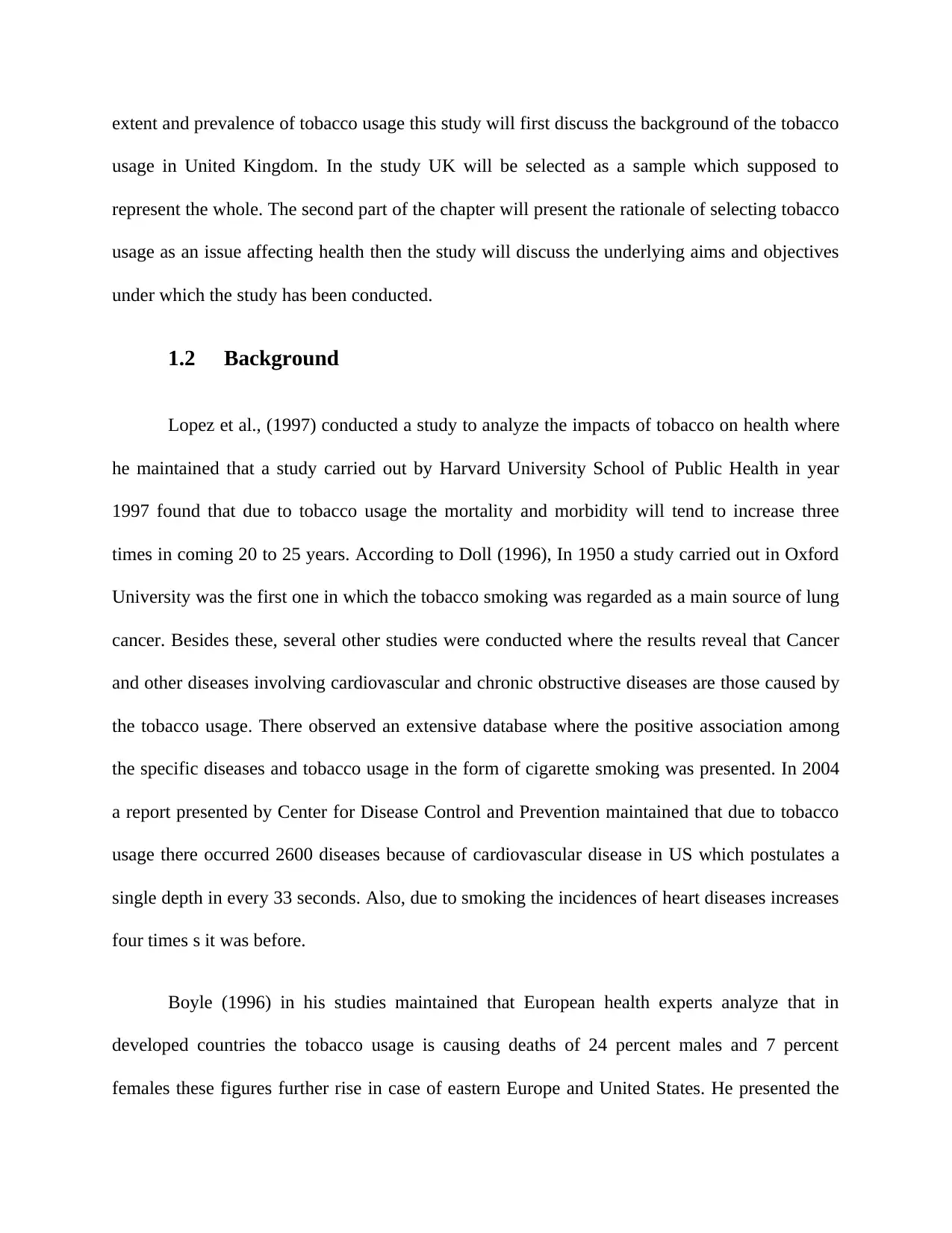
extent and prevalence of tobacco usage this study will first discuss the background of the tobacco
usage in United Kingdom. In the study UK will be selected as a sample which supposed to
represent the whole. The second part of the chapter will present the rationale of selecting tobacco
usage as an issue affecting health then the study will discuss the underlying aims and objectives
under which the study has been conducted.
1.2 Background
Lopez et al., (1997) conducted a study to analyze the impacts of tobacco on health where
he maintained that a study carried out by Harvard University School of Public Health in year
1997 found that due to tobacco usage the mortality and morbidity will tend to increase three
times in coming 20 to 25 years. According to Doll (1996), In 1950 a study carried out in Oxford
University was the first one in which the tobacco smoking was regarded as a main source of lung
cancer. Besides these, several other studies were conducted where the results reveal that Cancer
and other diseases involving cardiovascular and chronic obstructive diseases are those caused by
the tobacco usage. There observed an extensive database where the positive association among
the specific diseases and tobacco usage in the form of cigarette smoking was presented. In 2004
a report presented by Center for Disease Control and Prevention maintained that due to tobacco
usage there occurred 2600 diseases because of cardiovascular disease in US which postulates a
single depth in every 33 seconds. Also, due to smoking the incidences of heart diseases increases
four times s it was before.
Boyle (1996) in his studies maintained that European health experts analyze that in
developed countries the tobacco usage is causing deaths of 24 percent males and 7 percent
females these figures further rise in case of eastern Europe and United States. He presented the
usage in United Kingdom. In the study UK will be selected as a sample which supposed to
represent the whole. The second part of the chapter will present the rationale of selecting tobacco
usage as an issue affecting health then the study will discuss the underlying aims and objectives
under which the study has been conducted.
1.2 Background
Lopez et al., (1997) conducted a study to analyze the impacts of tobacco on health where
he maintained that a study carried out by Harvard University School of Public Health in year
1997 found that due to tobacco usage the mortality and morbidity will tend to increase three
times in coming 20 to 25 years. According to Doll (1996), In 1950 a study carried out in Oxford
University was the first one in which the tobacco smoking was regarded as a main source of lung
cancer. Besides these, several other studies were conducted where the results reveal that Cancer
and other diseases involving cardiovascular and chronic obstructive diseases are those caused by
the tobacco usage. There observed an extensive database where the positive association among
the specific diseases and tobacco usage in the form of cigarette smoking was presented. In 2004
a report presented by Center for Disease Control and Prevention maintained that due to tobacco
usage there occurred 2600 diseases because of cardiovascular disease in US which postulates a
single depth in every 33 seconds. Also, due to smoking the incidences of heart diseases increases
four times s it was before.
Boyle (1996) in his studies maintained that European health experts analyze that in
developed countries the tobacco usage is causing deaths of 24 percent males and 7 percent
females these figures further rise in case of eastern Europe and United States. He presented the
Paraphrase This Document
Need a fresh take? Get an instant paraphrase of this document with our AI Paraphraser
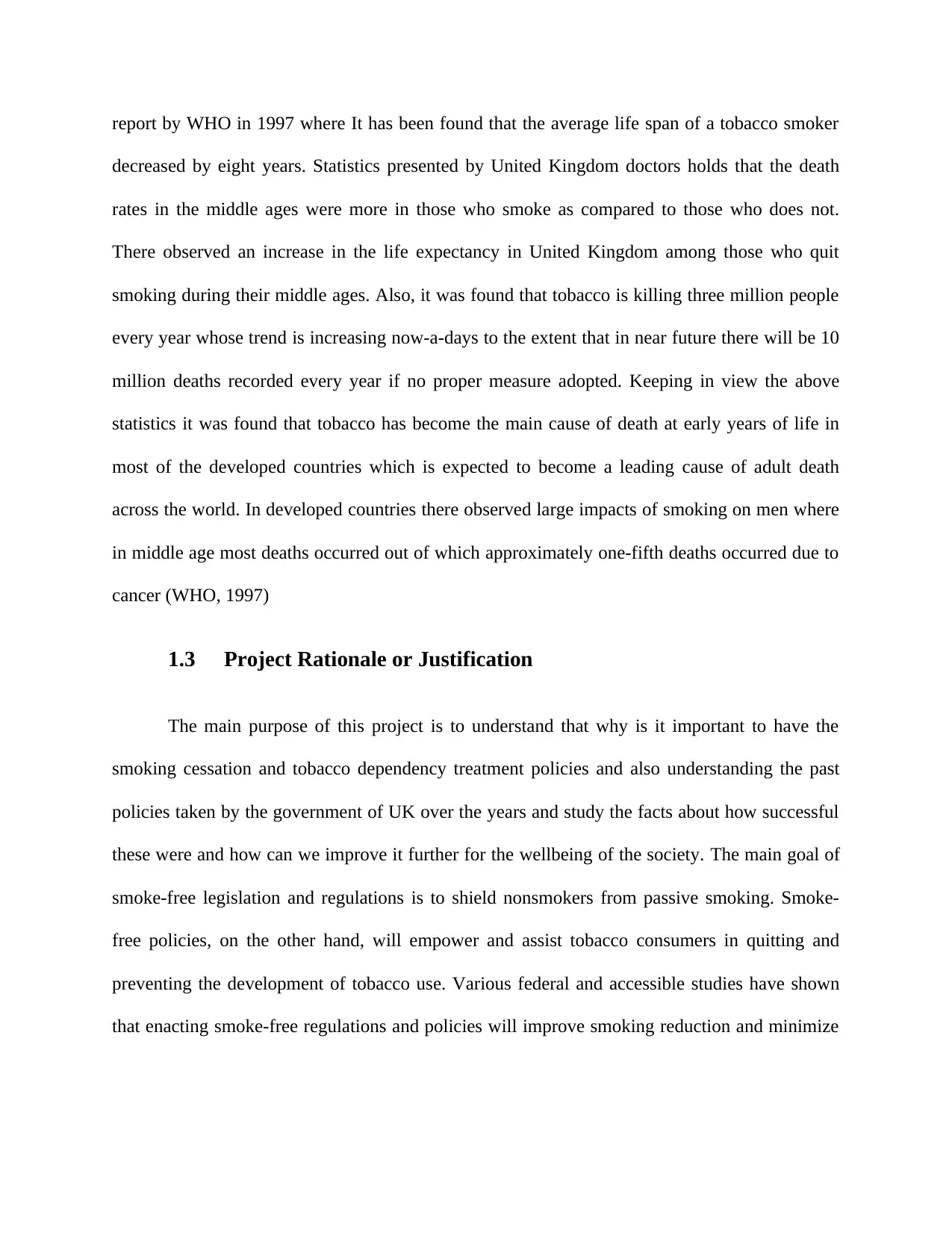
report by WHO in 1997 where It has been found that the average life span of a tobacco smoker
decreased by eight years. Statistics presented by United Kingdom doctors holds that the death
rates in the middle ages were more in those who smoke as compared to those who does not.
There observed an increase in the life expectancy in United Kingdom among those who quit
smoking during their middle ages. Also, it was found that tobacco is killing three million people
every year whose trend is increasing now-a-days to the extent that in near future there will be 10
million deaths recorded every year if no proper measure adopted. Keeping in view the above
statistics it was found that tobacco has become the main cause of death at early years of life in
most of the developed countries which is expected to become a leading cause of adult death
across the world. In developed countries there observed large impacts of smoking on men where
in middle age most deaths occurred out of which approximately one-fifth deaths occurred due to
cancer (WHO, 1997)
1.3 Project Rationale or Justification
The main purpose of this project is to understand that why is it important to have the
smoking cessation and tobacco dependency treatment policies and also understanding the past
policies taken by the government of UK over the years and study the facts about how successful
these were and how can we improve it further for the wellbeing of the society. The main goal of
smoke-free legislation and regulations is to shield nonsmokers from passive smoking. Smoke-
free policies, on the other hand, will empower and assist tobacco consumers in quitting and
preventing the development of tobacco use. Various federal and accessible studies have shown
that enacting smoke-free regulations and policies will improve smoking reduction and minimize
decreased by eight years. Statistics presented by United Kingdom doctors holds that the death
rates in the middle ages were more in those who smoke as compared to those who does not.
There observed an increase in the life expectancy in United Kingdom among those who quit
smoking during their middle ages. Also, it was found that tobacco is killing three million people
every year whose trend is increasing now-a-days to the extent that in near future there will be 10
million deaths recorded every year if no proper measure adopted. Keeping in view the above
statistics it was found that tobacco has become the main cause of death at early years of life in
most of the developed countries which is expected to become a leading cause of adult death
across the world. In developed countries there observed large impacts of smoking on men where
in middle age most deaths occurred out of which approximately one-fifth deaths occurred due to
cancer (WHO, 1997)
1.3 Project Rationale or Justification
The main purpose of this project is to understand that why is it important to have the
smoking cessation and tobacco dependency treatment policies and also understanding the past
policies taken by the government of UK over the years and study the facts about how successful
these were and how can we improve it further for the wellbeing of the society. The main goal of
smoke-free legislation and regulations is to shield nonsmokers from passive smoking. Smoke-
free policies, on the other hand, will empower and assist tobacco consumers in quitting and
preventing the development of tobacco use. Various federal and accessible studies have shown
that enacting smoke-free regulations and policies will improve smoking reduction and minimize
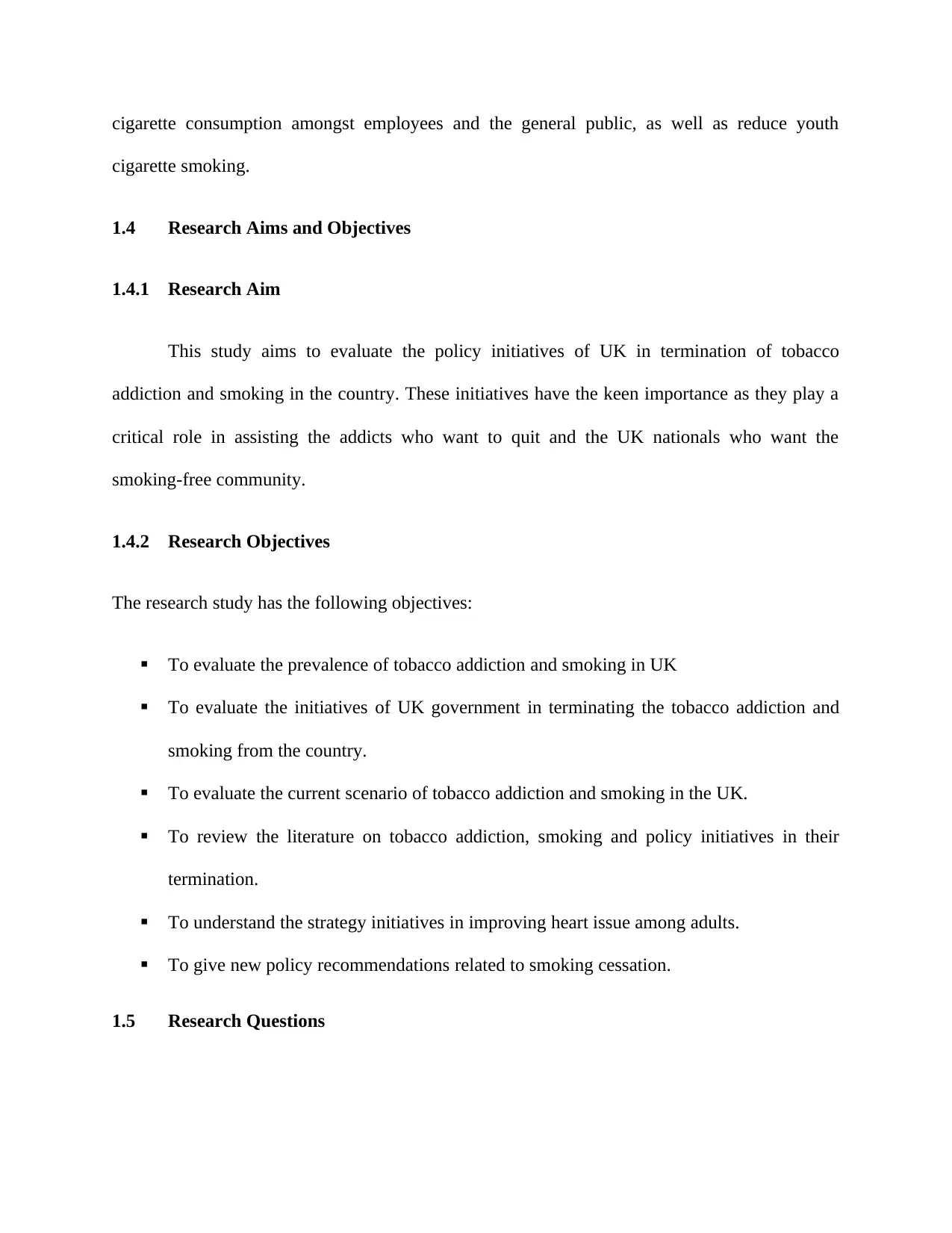
cigarette consumption amongst employees and the general public, as well as reduce youth
cigarette smoking.
1.4 Research Aims and Objectives
1.4.1 Research Aim
This study aims to evaluate the policy initiatives of UK in termination of tobacco
addiction and smoking in the country. These initiatives have the keen importance as they play a
critical role in assisting the addicts who want to quit and the UK nationals who want the
smoking-free community.
1.4.2 Research Objectives
The research study has the following objectives:
To evaluate the prevalence of tobacco addiction and smoking in UK
To evaluate the initiatives of UK government in terminating the tobacco addiction and
smoking from the country.
To evaluate the current scenario of tobacco addiction and smoking in the UK.
To review the literature on tobacco addiction, smoking and policy initiatives in their
termination.
To understand the strategy initiatives in improving heart issue among adults.
To give new policy recommendations related to smoking cessation.
1.5 Research Questions
cigarette smoking.
1.4 Research Aims and Objectives
1.4.1 Research Aim
This study aims to evaluate the policy initiatives of UK in termination of tobacco
addiction and smoking in the country. These initiatives have the keen importance as they play a
critical role in assisting the addicts who want to quit and the UK nationals who want the
smoking-free community.
1.4.2 Research Objectives
The research study has the following objectives:
To evaluate the prevalence of tobacco addiction and smoking in UK
To evaluate the initiatives of UK government in terminating the tobacco addiction and
smoking from the country.
To evaluate the current scenario of tobacco addiction and smoking in the UK.
To review the literature on tobacco addiction, smoking and policy initiatives in their
termination.
To understand the strategy initiatives in improving heart issue among adults.
To give new policy recommendations related to smoking cessation.
1.5 Research Questions
⊘ This is a preview!⊘
Do you want full access?
Subscribe today to unlock all pages.

Trusted by 1+ million students worldwide
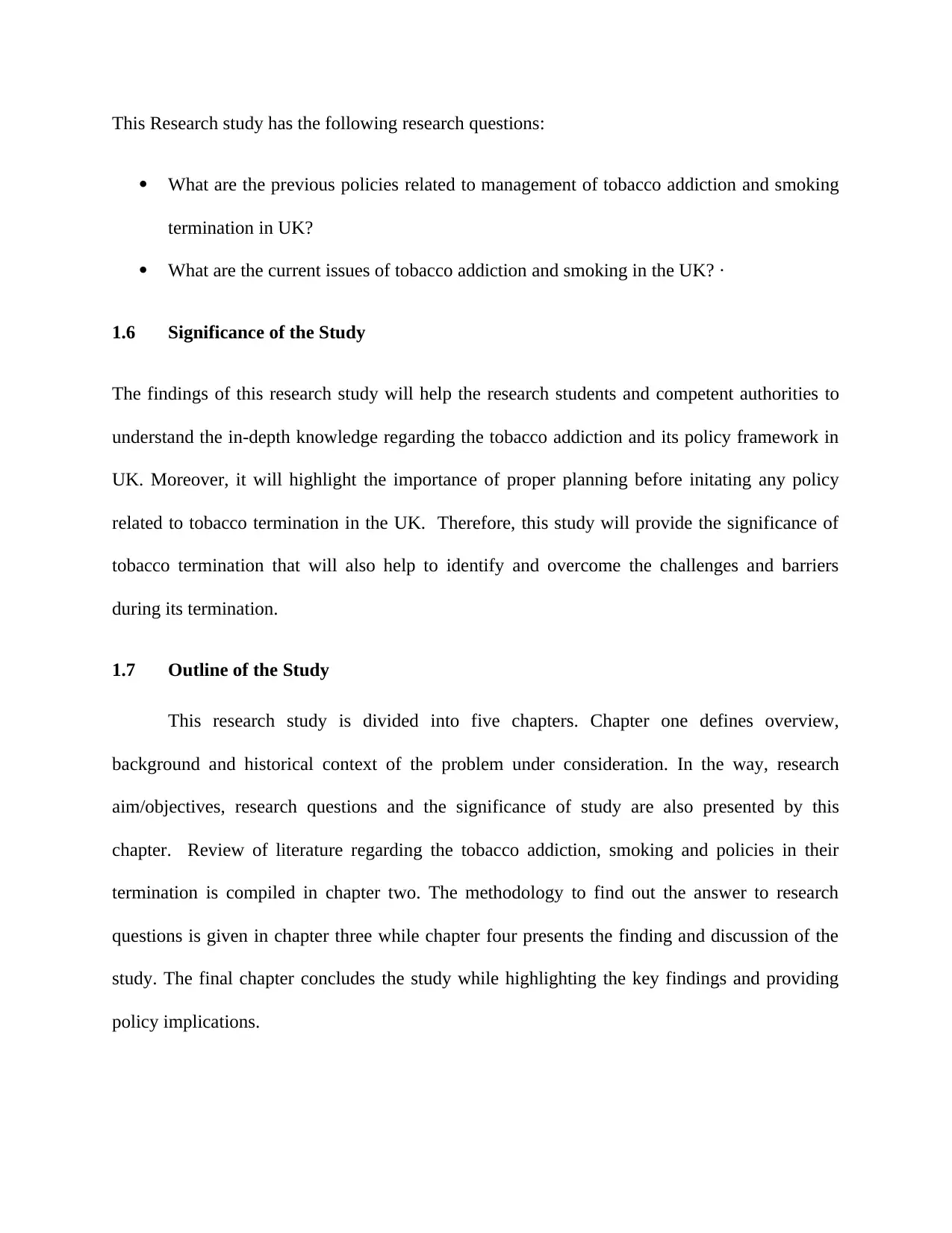
This Research study has the following research questions:
What are the previous policies related to management of tobacco addiction and smoking
termination in UK?
What are the current issues of tobacco addiction and smoking in the UK? ·
1.6 Significance of the Study
The findings of this research study will help the research students and competent authorities to
understand the in-depth knowledge regarding the tobacco addiction and its policy framework in
UK. Moreover, it will highlight the importance of proper planning before initating any policy
related to tobacco termination in the UK. Therefore, this study will provide the significance of
tobacco termination that will also help to identify and overcome the challenges and barriers
during its termination.
1.7 Outline of the Study
This research study is divided into five chapters. Chapter one defines overview,
background and historical context of the problem under consideration. In the way, research
aim/objectives, research questions and the significance of study are also presented by this
chapter. Review of literature regarding the tobacco addiction, smoking and policies in their
termination is compiled in chapter two. The methodology to find out the answer to research
questions is given in chapter three while chapter four presents the finding and discussion of the
study. The final chapter concludes the study while highlighting the key findings and providing
policy implications.
What are the previous policies related to management of tobacco addiction and smoking
termination in UK?
What are the current issues of tobacco addiction and smoking in the UK? ·
1.6 Significance of the Study
The findings of this research study will help the research students and competent authorities to
understand the in-depth knowledge regarding the tobacco addiction and its policy framework in
UK. Moreover, it will highlight the importance of proper planning before initating any policy
related to tobacco termination in the UK. Therefore, this study will provide the significance of
tobacco termination that will also help to identify and overcome the challenges and barriers
during its termination.
1.7 Outline of the Study
This research study is divided into five chapters. Chapter one defines overview,
background and historical context of the problem under consideration. In the way, research
aim/objectives, research questions and the significance of study are also presented by this
chapter. Review of literature regarding the tobacco addiction, smoking and policies in their
termination is compiled in chapter two. The methodology to find out the answer to research
questions is given in chapter three while chapter four presents the finding and discussion of the
study. The final chapter concludes the study while highlighting the key findings and providing
policy implications.
Paraphrase This Document
Need a fresh take? Get an instant paraphrase of this document with our AI Paraphraser
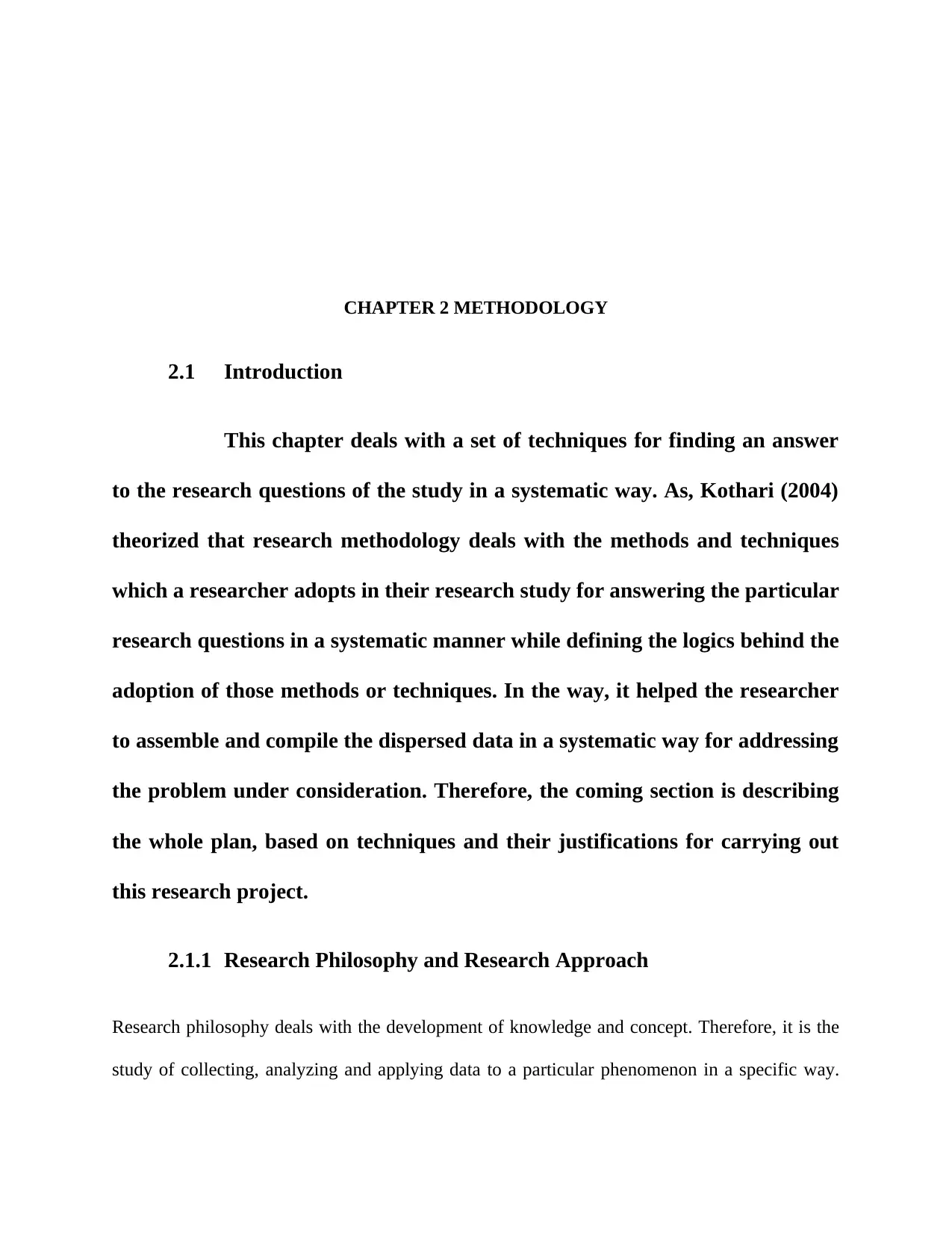
CHAPTER 2 METHODOLOGY
2.1 Introduction
This chapter deals with a set of techniques for finding an answer
to the research questions of the study in a systematic way. As, Kothari (2004)
theorized that research methodology deals with the methods and techniques
which a researcher adopts in their research study for answering the particular
research questions in a systematic manner while defining the logics behind the
adoption of those methods or techniques. In the way, it helped the researcher
to assemble and compile the dispersed data in a systematic way for addressing
the problem under consideration. Therefore, the coming section is describing
the whole plan, based on techniques and their justifications for carrying out
this research project.
2.1.1 Research Philosophy and Research Approach
Research philosophy deals with the development of knowledge and concept. Therefore, it is the
study of collecting, analyzing and applying data to a particular phenomenon in a specific way.
2.1 Introduction
This chapter deals with a set of techniques for finding an answer
to the research questions of the study in a systematic way. As, Kothari (2004)
theorized that research methodology deals with the methods and techniques
which a researcher adopts in their research study for answering the particular
research questions in a systematic manner while defining the logics behind the
adoption of those methods or techniques. In the way, it helped the researcher
to assemble and compile the dispersed data in a systematic way for addressing
the problem under consideration. Therefore, the coming section is describing
the whole plan, based on techniques and their justifications for carrying out
this research project.
2.1.1 Research Philosophy and Research Approach
Research philosophy deals with the development of knowledge and concept. Therefore, it is the
study of collecting, analyzing and applying data to a particular phenomenon in a specific way.
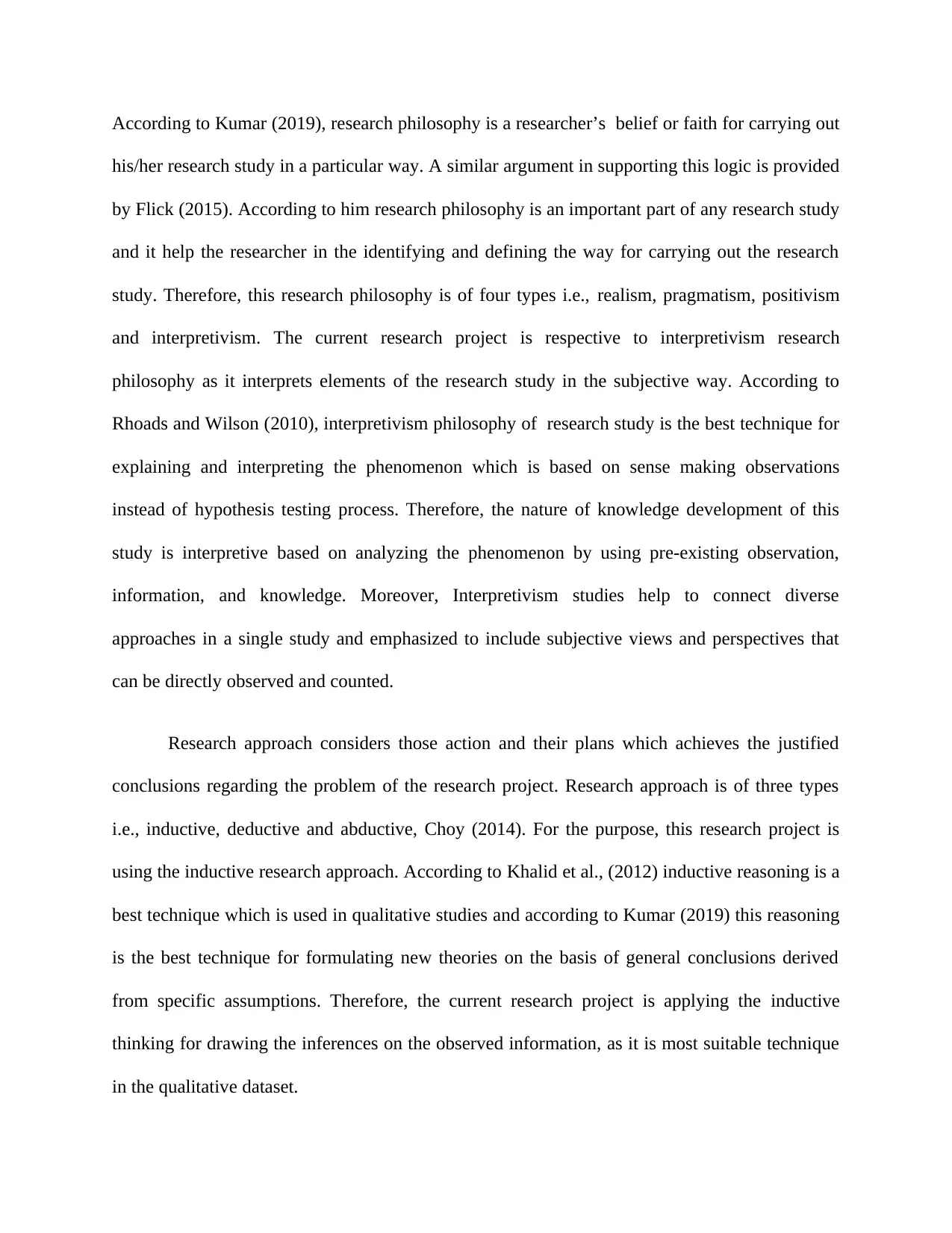
According to Kumar (2019), research philosophy is a researcher’s belief or faith for carrying out
his/her research study in a particular way. A similar argument in supporting this logic is provided
by Flick (2015). According to him research philosophy is an important part of any research study
and it help the researcher in the identifying and defining the way for carrying out the research
study. Therefore, this research philosophy is of four types i.e., realism, pragmatism, positivism
and interpretivism. The current research project is respective to interpretivism research
philosophy as it interprets elements of the research study in the subjective way. According to
Rhoads and Wilson (2010), interpretivism philosophy of research study is the best technique for
explaining and interpreting the phenomenon which is based on sense making observations
instead of hypothesis testing process. Therefore, the nature of knowledge development of this
study is interpretive based on analyzing the phenomenon by using pre-existing observation,
information, and knowledge. Moreover, Interpretivism studies help to connect diverse
approaches in a single study and emphasized to include subjective views and perspectives that
can be directly observed and counted.
Research approach considers those action and their plans which achieves the justified
conclusions regarding the problem of the research project. Research approach is of three types
i.e., inductive, deductive and abductive, Choy (2014). For the purpose, this research project is
using the inductive research approach. According to Khalid et al., (2012) inductive reasoning is a
best technique which is used in qualitative studies and according to Kumar (2019) this reasoning
is the best technique for formulating new theories on the basis of general conclusions derived
from specific assumptions. Therefore, the current research project is applying the inductive
thinking for drawing the inferences on the observed information, as it is most suitable technique
in the qualitative dataset.
his/her research study in a particular way. A similar argument in supporting this logic is provided
by Flick (2015). According to him research philosophy is an important part of any research study
and it help the researcher in the identifying and defining the way for carrying out the research
study. Therefore, this research philosophy is of four types i.e., realism, pragmatism, positivism
and interpretivism. The current research project is respective to interpretivism research
philosophy as it interprets elements of the research study in the subjective way. According to
Rhoads and Wilson (2010), interpretivism philosophy of research study is the best technique for
explaining and interpreting the phenomenon which is based on sense making observations
instead of hypothesis testing process. Therefore, the nature of knowledge development of this
study is interpretive based on analyzing the phenomenon by using pre-existing observation,
information, and knowledge. Moreover, Interpretivism studies help to connect diverse
approaches in a single study and emphasized to include subjective views and perspectives that
can be directly observed and counted.
Research approach considers those action and their plans which achieves the justified
conclusions regarding the problem of the research project. Research approach is of three types
i.e., inductive, deductive and abductive, Choy (2014). For the purpose, this research project is
using the inductive research approach. According to Khalid et al., (2012) inductive reasoning is a
best technique which is used in qualitative studies and according to Kumar (2019) this reasoning
is the best technique for formulating new theories on the basis of general conclusions derived
from specific assumptions. Therefore, the current research project is applying the inductive
thinking for drawing the inferences on the observed information, as it is most suitable technique
in the qualitative dataset.
⊘ This is a preview!⊘
Do you want full access?
Subscribe today to unlock all pages.

Trusted by 1+ million students worldwide
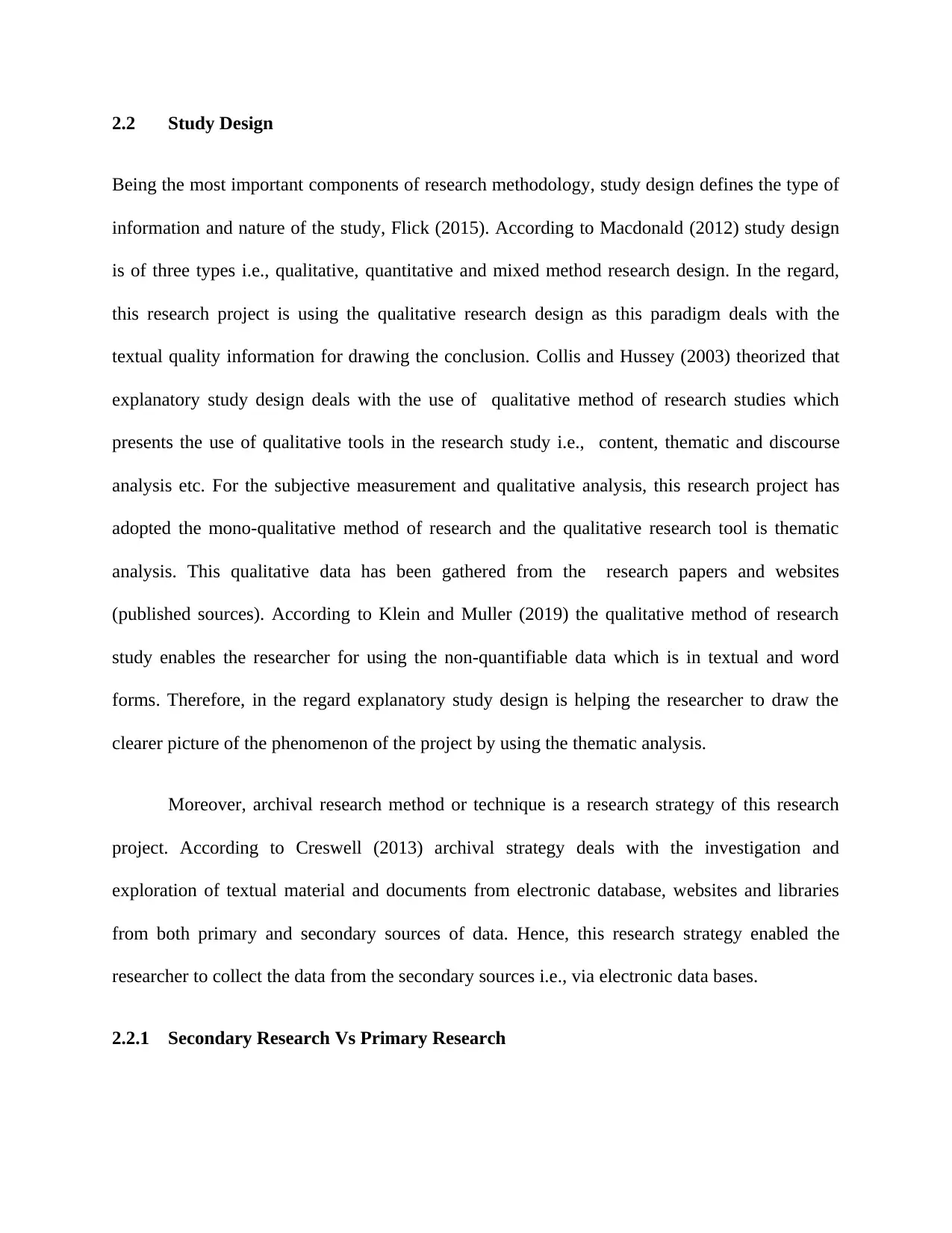
2.2 Study Design
Being the most important components of research methodology, study design defines the type of
information and nature of the study, Flick (2015). According to Macdonald (2012) study design
is of three types i.e., qualitative, quantitative and mixed method research design. In the regard,
this research project is using the qualitative research design as this paradigm deals with the
textual quality information for drawing the conclusion. Collis and Hussey (2003) theorized that
explanatory study design deals with the use of qualitative method of research studies which
presents the use of qualitative tools in the research study i.e., content, thematic and discourse
analysis etc. For the subjective measurement and qualitative analysis, this research project has
adopted the mono-qualitative method of research and the qualitative research tool is thematic
analysis. This qualitative data has been gathered from the research papers and websites
(published sources). According to Klein and Muller (2019) the qualitative method of research
study enables the researcher for using the non-quantifiable data which is in textual and word
forms. Therefore, in the regard explanatory study design is helping the researcher to draw the
clearer picture of the phenomenon of the project by using the thematic analysis.
Moreover, archival research method or technique is a research strategy of this research
project. According to Creswell (2013) archival strategy deals with the investigation and
exploration of textual material and documents from electronic database, websites and libraries
from both primary and secondary sources of data. Hence, this research strategy enabled the
researcher to collect the data from the secondary sources i.e., via electronic data bases.
2.2.1 Secondary Research Vs Primary Research
Being the most important components of research methodology, study design defines the type of
information and nature of the study, Flick (2015). According to Macdonald (2012) study design
is of three types i.e., qualitative, quantitative and mixed method research design. In the regard,
this research project is using the qualitative research design as this paradigm deals with the
textual quality information for drawing the conclusion. Collis and Hussey (2003) theorized that
explanatory study design deals with the use of qualitative method of research studies which
presents the use of qualitative tools in the research study i.e., content, thematic and discourse
analysis etc. For the subjective measurement and qualitative analysis, this research project has
adopted the mono-qualitative method of research and the qualitative research tool is thematic
analysis. This qualitative data has been gathered from the research papers and websites
(published sources). According to Klein and Muller (2019) the qualitative method of research
study enables the researcher for using the non-quantifiable data which is in textual and word
forms. Therefore, in the regard explanatory study design is helping the researcher to draw the
clearer picture of the phenomenon of the project by using the thematic analysis.
Moreover, archival research method or technique is a research strategy of this research
project. According to Creswell (2013) archival strategy deals with the investigation and
exploration of textual material and documents from electronic database, websites and libraries
from both primary and secondary sources of data. Hence, this research strategy enabled the
researcher to collect the data from the secondary sources i.e., via electronic data bases.
2.2.1 Secondary Research Vs Primary Research
Paraphrase This Document
Need a fresh take? Get an instant paraphrase of this document with our AI Paraphraser
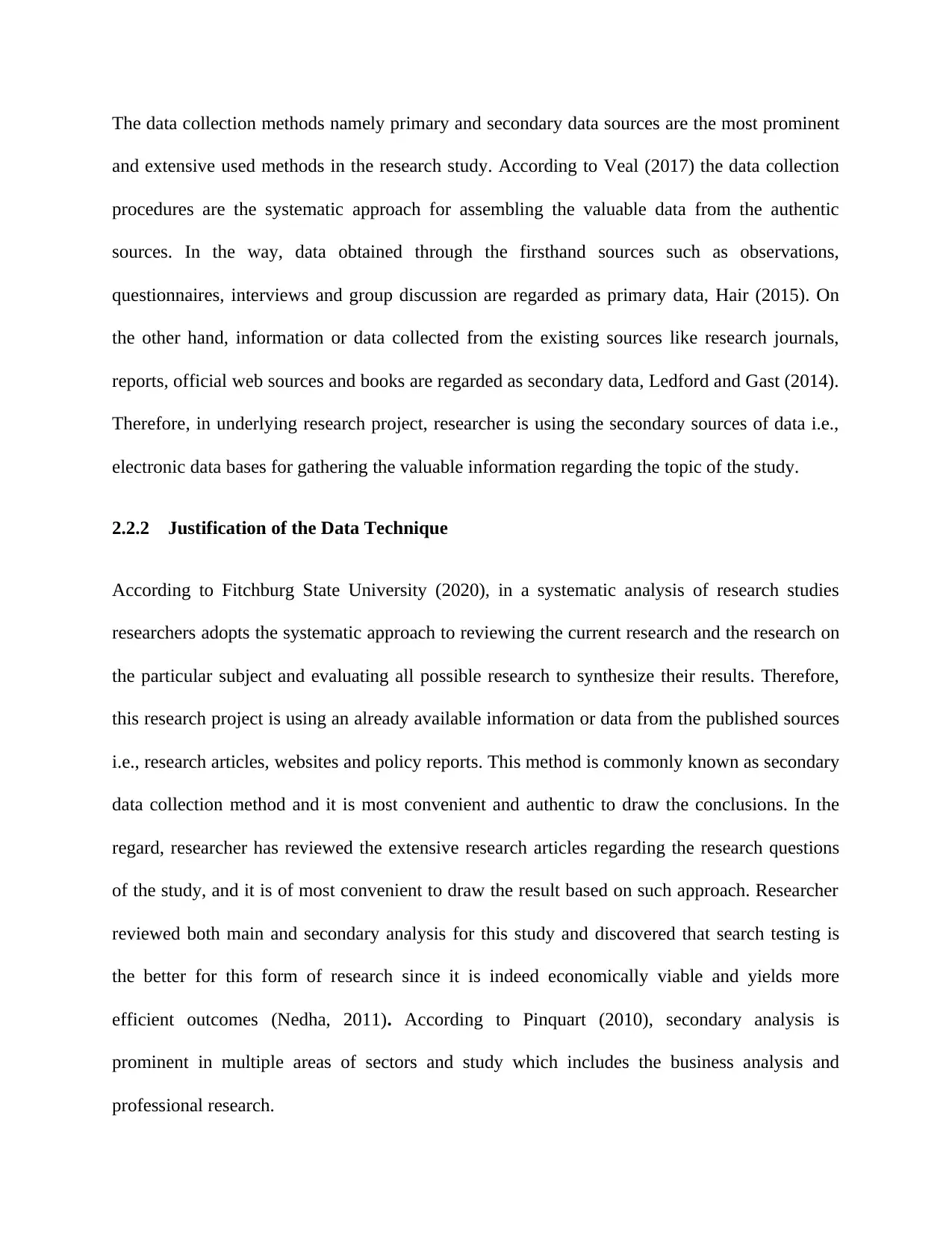
The data collection methods namely primary and secondary data sources are the most prominent
and extensive used methods in the research study. According to Veal (2017) the data collection
procedures are the systematic approach for assembling the valuable data from the authentic
sources. In the way, data obtained through the firsthand sources such as observations,
questionnaires, interviews and group discussion are regarded as primary data, Hair (2015). On
the other hand, information or data collected from the existing sources like research journals,
reports, official web sources and books are regarded as secondary data, Ledford and Gast (2014).
Therefore, in underlying research project, researcher is using the secondary sources of data i.e.,
electronic data bases for gathering the valuable information regarding the topic of the study.
2.2.2 Justification of the Data Technique
According to Fitchburg State University (2020), in a systematic analysis of research studies
researchers adopts the systematic approach to reviewing the current research and the research on
the particular subject and evaluating all possible research to synthesize their results. Therefore,
this research project is using an already available information or data from the published sources
i.e., research articles, websites and policy reports. This method is commonly known as secondary
data collection method and it is most convenient and authentic to draw the conclusions. In the
regard, researcher has reviewed the extensive research articles regarding the research questions
of the study, and it is of most convenient to draw the result based on such approach. Researcher
reviewed both main and secondary analysis for this study and discovered that search testing is
the better for this form of research since it is indeed economically viable and yields more
efficient outcomes (Nedha, 2011). According to Pinquart (2010), secondary analysis is
prominent in multiple areas of sectors and study which includes the business analysis and
professional research.
and extensive used methods in the research study. According to Veal (2017) the data collection
procedures are the systematic approach for assembling the valuable data from the authentic
sources. In the way, data obtained through the firsthand sources such as observations,
questionnaires, interviews and group discussion are regarded as primary data, Hair (2015). On
the other hand, information or data collected from the existing sources like research journals,
reports, official web sources and books are regarded as secondary data, Ledford and Gast (2014).
Therefore, in underlying research project, researcher is using the secondary sources of data i.e.,
electronic data bases for gathering the valuable information regarding the topic of the study.
2.2.2 Justification of the Data Technique
According to Fitchburg State University (2020), in a systematic analysis of research studies
researchers adopts the systematic approach to reviewing the current research and the research on
the particular subject and evaluating all possible research to synthesize their results. Therefore,
this research project is using an already available information or data from the published sources
i.e., research articles, websites and policy reports. This method is commonly known as secondary
data collection method and it is most convenient and authentic to draw the conclusions. In the
regard, researcher has reviewed the extensive research articles regarding the research questions
of the study, and it is of most convenient to draw the result based on such approach. Researcher
reviewed both main and secondary analysis for this study and discovered that search testing is
the better for this form of research since it is indeed economically viable and yields more
efficient outcomes (Nedha, 2011). According to Pinquart (2010), secondary analysis is
prominent in multiple areas of sectors and study which includes the business analysis and
professional research.
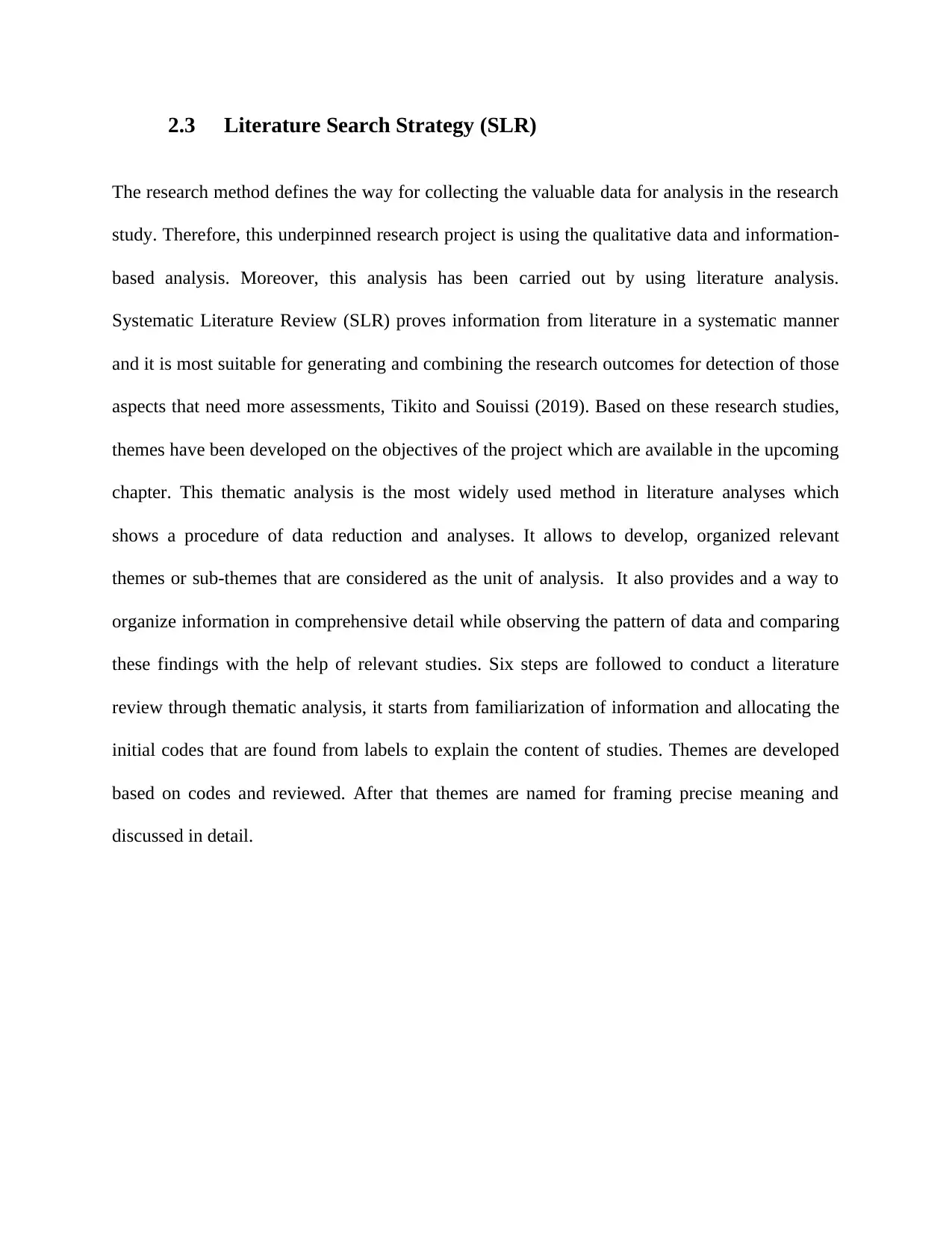
2.3 Literature Search Strategy (SLR)
The research method defines the way for collecting the valuable data for analysis in the research
study. Therefore, this underpinned research project is using the qualitative data and information-
based analysis. Moreover, this analysis has been carried out by using literature analysis.
Systematic Literature Review (SLR) proves information from literature in a systematic manner
and it is most suitable for generating and combining the research outcomes for detection of those
aspects that need more assessments, Tikito and Souissi (2019). Based on these research studies,
themes have been developed on the objectives of the project which are available in the upcoming
chapter. This thematic analysis is the most widely used method in literature analyses which
shows a procedure of data reduction and analyses. It allows to develop, organized relevant
themes or sub-themes that are considered as the unit of analysis. It also provides and a way to
organize information in comprehensive detail while observing the pattern of data and comparing
these findings with the help of relevant studies. Six steps are followed to conduct a literature
review through thematic analysis, it starts from familiarization of information and allocating the
initial codes that are found from labels to explain the content of studies. Themes are developed
based on codes and reviewed. After that themes are named for framing precise meaning and
discussed in detail.
The research method defines the way for collecting the valuable data for analysis in the research
study. Therefore, this underpinned research project is using the qualitative data and information-
based analysis. Moreover, this analysis has been carried out by using literature analysis.
Systematic Literature Review (SLR) proves information from literature in a systematic manner
and it is most suitable for generating and combining the research outcomes for detection of those
aspects that need more assessments, Tikito and Souissi (2019). Based on these research studies,
themes have been developed on the objectives of the project which are available in the upcoming
chapter. This thematic analysis is the most widely used method in literature analyses which
shows a procedure of data reduction and analyses. It allows to develop, organized relevant
themes or sub-themes that are considered as the unit of analysis. It also provides and a way to
organize information in comprehensive detail while observing the pattern of data and comparing
these findings with the help of relevant studies. Six steps are followed to conduct a literature
review through thematic analysis, it starts from familiarization of information and allocating the
initial codes that are found from labels to explain the content of studies. Themes are developed
based on codes and reviewed. After that themes are named for framing precise meaning and
discussed in detail.
⊘ This is a preview!⊘
Do you want full access?
Subscribe today to unlock all pages.

Trusted by 1+ million students worldwide
1 out of 31
Related Documents
Your All-in-One AI-Powered Toolkit for Academic Success.
+13062052269
info@desklib.com
Available 24*7 on WhatsApp / Email
![[object Object]](/_next/static/media/star-bottom.7253800d.svg)
Unlock your academic potential
Copyright © 2020–2025 A2Z Services. All Rights Reserved. Developed and managed by ZUCOL.





